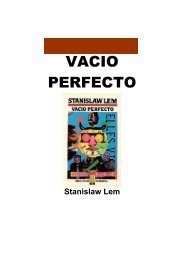cambridge-crime-fiction
cambridge-crime-fiction
cambridge-crime-fiction
Create successful ePaper yourself
Turn your PDF publications into a flip-book with our unique Google optimized e-Paper software.
leroy l. panek<br />
But the police novel began slowly. Until the mid-1980s, police novels<br />
formed a very small pocket in the garment of <strong>crime</strong> <strong>fiction</strong>. Moreover, the<br />
few critics who found them worthy of comment defined the genre by applying<br />
to the police novel the criteria of the detective story developed in the<br />
1920s and 1930s –the need for clues, for a surprise ending, and all of the<br />
other conventions adhered to by critics and writers alike. Thus the notion<br />
formed that the ‘police procedural’ should be a standard mystery novel in<br />
which police work influenced the ways in which characters behave and also<br />
provided the ancillary furniture necessary to stretch the surprise detective<br />
plot into the length of a novel. This definition never quite worked. From<br />
early on it left such important and influential <strong>fiction</strong> as McKinley Kantor’s<br />
Signal Thirty-Two (1950) and then Joseph Wambaugh’s The New Centurions<br />
(1970), The Blue Knight (1972), and The Choirboys (1973) outside the<br />
genre. The restrictive definition, moreover, overlooked the fact that from the<br />
late 1960s onwards the police novel began to appear in a variety of forms<br />
from the standard whodunit to the thriller and even to the love romance.<br />
And regardless of their narrative structure, all of these forms focused on the<br />
same essential point – that <strong>crime</strong> and police work have a unique impact on<br />
the way men and women work as well as the way they live.<br />
While the police novel’s origins can be found at mid-century, most of its<br />
practitioners began from or after the 1980s: Joanna C. Hazelden’s list of<br />
police <strong>fiction</strong> posted on the Chicago Public Library’s website (2002) cites<br />
thirty-nine police writers who began writing after 1984 compared to nine<br />
whose first works appeared between 1970 and 1983, and six who began writing<br />
police <strong>fiction</strong> in the 1950s and 1960s. And such significant recent writers<br />
as Robert Daley, Ridley Pearson, Patricia Cornwell, and Dan Mahoney do<br />
not appear on her list. No matter how slowly it started, however, the police<br />
novel began immediately following the Second World War and its apprenticeship<br />
extended from the publication of Lawrence Treat’s VasinVictim<br />
in 1945 roughly to the publication of Joseph Wambaugh’s The Choirboys in<br />
1973.<br />
For Treat, VasinVictim was simply another attempt to provide the kind of<br />
variety within a pattern that drives the market for detective mystery novels.<br />
In VasinVictim he introduced a pair of New York police officers, Mitch<br />
Taylor and Jub Freeman. With Freeman Treat simply carried on the tradition<br />
of scientific detection begun at the turn of the century by his character’s<br />
namesake, R. Austin Freeman. With Mitch Taylor came the innovation:<br />
Taylor possessed traditional, routine police wisdom combined with cynicism,<br />
exhaustion, and the attitudes and values of the lower middle class. In short,<br />
in Mitch Taylor Treat introduced a character who mirrored the background,<br />
attitudes, and aptitudes of real police officers.<br />
156



